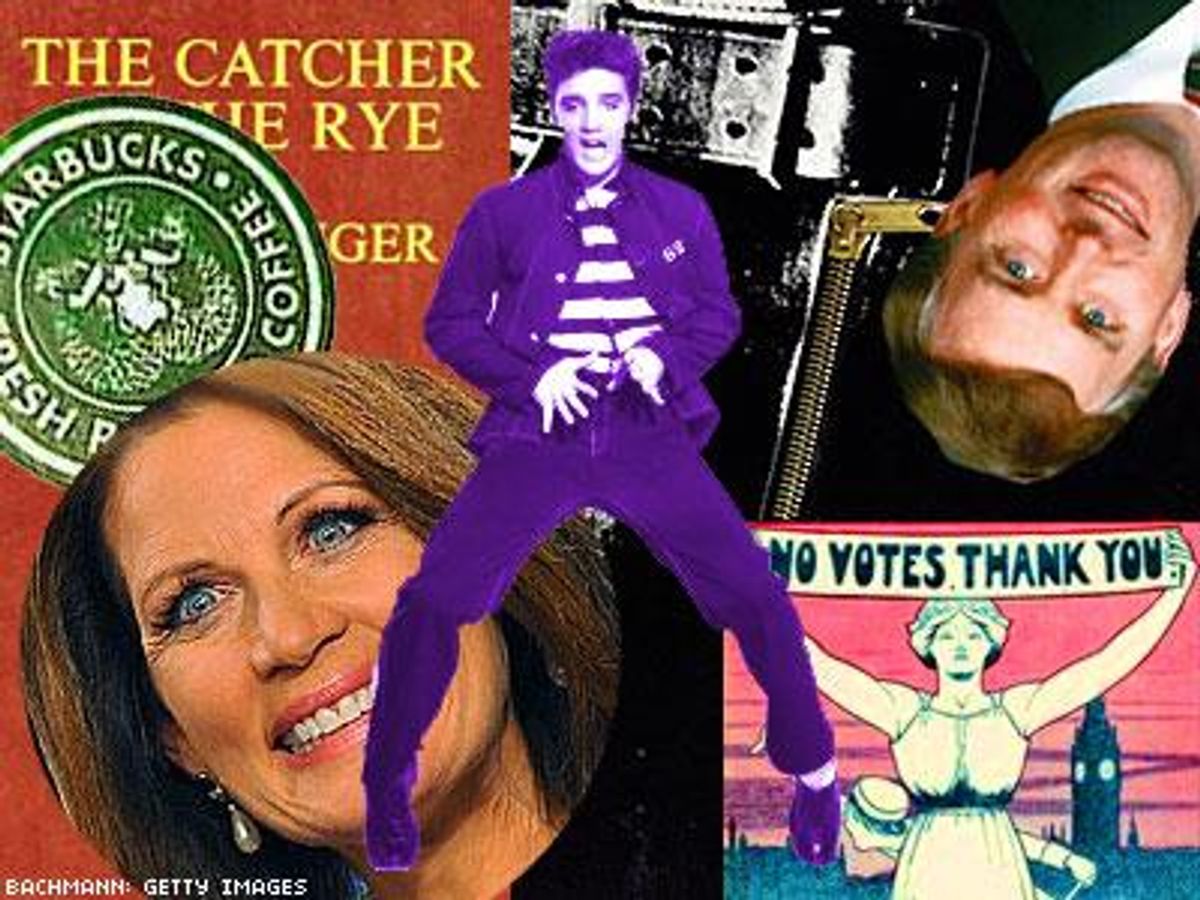 Above left: A page from Kate Shippen Roosevelt's scrapbook. Above right: Dr. Anna Shaw supresses a smile.
Above left: A page from Kate Shippen Roosevelt's scrapbook. Above right: Dr. Anna Shaw supresses a smile.
Women's Suffrage: "Simply Unnecessary"
In the early 1900s Kate Shippen Roosevelt, the widow of Theodore Roosevelt's first cousin, Hilborne L. Roosevelt, opposed women gaining the right to vote. She was wealthy, connected, and politically active. In her diary she claimed that women's right to vote was "simply unnecessary." It's easy of course to find the historical references of men battling the Suffrage Cause, but examples like Mrs. Roosevelt were shockingly common as well.
The President of the National American Women's Suffrage Association, Dr. Anna Shaw, called anti-suffragists the "home, hearth and mother crowd." When asked why there was no marriage in heaven, Dr. Shaw brazenly responded, "Because there are no men in heaven." She felt women joining forces could live happily in a female-dominated world. When she died in 1919, at her beside was Lucy Anthony (Susan B. Anthony's niece). Called her "intimate companion," Lucy Anthony lived with Dr. Shaw for 30 years. (Source: ultimatehistoryproject.com)
 Above left: A 1937 ad touting zippers. Above right: Andy Warhol's Sticky Fingers album cover with real zipper.
Above left: A 1937 ad touting zippers. Above right: Andy Warhol's Sticky Fingers album cover with real zipper.
The Zipper: How the Devil Gets In Your Pants
The zipper as an invention was created in the late 1800s, but it's common use in clothing didn't take hold until the '30s. Esquire magazine declared the zipper the "Newest Tailoring Idea for Men" and among the zippered fly's many virtues was that it would exclude "The Possibility of Unintentional and Embarrassing Disarray." Obviously, the new zippered trouser owners had not yet discovered the experience of forgetting to zip-up. But at the same time Christian Crusaders decried the zipper as the quick access opening to Hell. As late as 2011, Pastor Sydney Marlin claimed its sinful heritage in the book, Woman, Yes You Can! from Xulon Press. He writes "My wife, has at times worn front zipper jeans or other types and I said nothing about it when I should have. We have allowed what we think is right to override what God mandates as not culturally acceptable." Then there's Vivian Westwood.
 Above: Loaded into the paddy wagon simply for wearing women's clothing.
Above: Loaded into the paddy wagon simply for wearing women's clothing. Drag Behind Bars: The Crime of Female Impersonation
It wasn't until the late 1960s in New York that a man could walk peacefully down the street in a pair of sling backs. Men wearing women's clothing was considered a pernicious crime and the police and lawmakers aggressively pursued the so-called criminals. Stringent laws allowed men to wear women's clothing only on stage in theatrical performances. The famous drag balls in the first half of the 20th century tensely flaunted those laws with sometimes tragic results. In the 2010 documentary Beautiful Darling about transgender Warhol Superstar Candy Darling, Holly Woodlwan talks about the period of time when the police would stop her on the street and shine a flashlight into her eyes looking for traces of mascara. If they saw it? Off she went to jail.
Below: Catch Fran Lebowitz's wrong side of history transphobia in the trailer for Beautiful Darling.
 Above left: An early hardcover edition. Above right: Michelle Williams can't put the book down, even on the red carpet.
Above left: An early hardcover edition. Above right: Michelle Williams can't put the book down, even on the red carpet.The Catcher in the Rye: Banned and Beloved
The Catcher In the Rye is still one of the most popular books ever written, reaching the New York Times best-seller list in the first two weeks after publication. But that didn't keep it off the censors' lists. The American Library Association maintains it is still a favorite with censors. Even 10 years after its 1951 publication, teachers were losing their jobs for assigning their students to read the book. A community in Columbus Ohio deemed the book "antiwhite." When author J.D. Salinger died in 2010, sales of his book charted over half a million.
Elvis = The Devil: Whatever You Do, Don't Look at His Hips
Elvis Presley was shocking. His blatantly sexual physical humping and gyrations caused the concerns of a postwar, conservative America. Ed Sullivan initially did not want Elvis on his television show, but ratings won out on September 9, 1956. Ironically enough, Sullivan was sick and could not host the show, so his stand in for the night was gay actor, Charles Laughton. That year, in Jacksonville, Florida, Pastor Bob Gray (above left) expressed disapproval of Elvis Presley as "a new low in spiritual degeneracy." In 2007 Gray died one week before he was to stand trial for molesting several girls while he was a pastor.
Also in 1956 in Jacksonville, Florida, Judge Marion Gooding had prepared an arrest warrant for Presley charging him with impairing the morals of minors in the event that Elvis swiveled his hips. Young people at the Murray Hill Methodist Church heard Elvis denounced in a sermon entitled, "Hotrods, Reefers, and Rock and Roll." (Source:
elvisnews.com)
Statistically, Presley holds records for the most Top 40 hits (107), the most Top 10 hits (38), the most consecutive Number One hits (10) and the most weeks at Number One (80). Elvis Presley was inducted into the Rock and Roll Hall of Fame in 1986. (Source:
rockhall.com)
Below: Elvis on the Ed Sullivan Show in 1956.
 Above left: Perry Smith, one of the two main subjects of Truman Capote's In Cold Blood and long rumored to have been Capote's lover. Above right: Tattoo of Audrey Hepburn as Holly Golightly in the film version of Breakfast at Tiffany's by E-Nigma Design
Above left: Perry Smith, one of the two main subjects of Truman Capote's In Cold Blood and long rumored to have been Capote's lover. Above right: Tattoo of Audrey Hepburn as Holly Golightly in the film version of Breakfast at Tiffany's by E-Nigma Design
Truman Capote's Tattoo Tirade
"There's something really the matter with most people who wear tattoos. There's at least some terrible story. I know from experience that there's always something terribly flawed about people who are tattooed, above some little something that Johnny had done in the Navy, even though that's a bad sign...It's terrible. Psychologically it's crazy. Most people who are tattooed, it's the sign of some feeling of inferiority, they're trying to establish some macho identification for themselves." -- Truman Capote
Above: Dan Quayle speaks, and reacts to Murphy Brown.
What About the Children?: Dan Quayle Speaks Out for the Welfare of Fictional Characters
In Murphy Brown's 1991-92 season, Murphy (played by Candace Bergen) became pregnant. At the point where the character was about to give birth, Murphy had stated that "several people do not want me to have the baby. Pat Robertson; Phyllis Schlafly; half of Utah!" Out of the mouths of actresses.... On May 19, 1992, Vice President Dan Quayle spoke at the Commonwealth Club in San Francisco. During his speech, he criticized the Murphy Brown character for "ignoring the importance of fathers by birthing a child alone." The following national debate, media coverage, and inclusion of Quayle's comments in the plot of the show resulted in a fresh view on the diversity of families in America.
Below: Murphy Brown, with child.
Fire and Ice: Michele Bachmann on Climate ChangeWhy would you go to Michele Bachmann for any factual information about science? Maybe Bachmann is actually the perfect poster girl to represent climate change deniers. Why do conservatives have so little interest in conservation?

Coffee of Ill Repute and the Starbucks Slut
A few years ago, Starbucks reintroduced their siren logo, a mermaid of sorts with a flayed tail. The logo is based on an old sixteenth-century Norse woodcut: a two-tailed mermaid, or siren, encircled by the store's original name. Room for milk with your Christian backlash? In a Mother Jones article we get this fervid quote: "The Starbucks logo has a naked woman on it with her legs spread like a prostitute," explains alarmist Mark Dice, of a Christian group called The Resistance. "Need I say more? It's extremely poor taste, and the company might as well call themselves Slutbucks." May we suggest a calming herbal tea, Mr. Dice?


 Above left: A page from Kate Shippen Roosevelt's scrapbook. Above right: Dr. Anna Shaw supresses a smile.
Above left: A page from Kate Shippen Roosevelt's scrapbook. Above right: Dr. Anna Shaw supresses a smile. Above left: A 1937 ad touting zippers. Above right: Andy Warhol's Sticky Fingers album cover with real zipper.
Above left: A 1937 ad touting zippers. Above right: Andy Warhol's Sticky Fingers album cover with real zipper.





























 Above: Loaded into the paddy wagon simply for wearing women's clothing.
Above: Loaded into the paddy wagon simply for wearing women's clothing.  Above left: An early hardcover edition. Above right: Michelle Williams can't put the book down, even on the red carpet.
Above left: An early hardcover edition. Above right: Michelle Williams can't put the book down, even on the red carpet. Elvis Presley was shocking. His blatantly sexual physical humping and gyrations caused the concerns of a postwar, conservative America. Ed Sullivan initially did not want Elvis on his television show, but ratings won out on September 9, 1956. Ironically enough, Sullivan was sick and could not host the show, so his stand in for the night was gay actor, Charles Laughton. That year, in Jacksonville, Florida, Pastor Bob Gray (above left) expressed disapproval of Elvis Presley as "a new low in spiritual degeneracy." In 2007 Gray died one week before he was to stand trial for molesting several girls while he was a pastor.
Elvis Presley was shocking. His blatantly sexual physical humping and gyrations caused the concerns of a postwar, conservative America. Ed Sullivan initially did not want Elvis on his television show, but ratings won out on September 9, 1956. Ironically enough, Sullivan was sick and could not host the show, so his stand in for the night was gay actor, Charles Laughton. That year, in Jacksonville, Florida, Pastor Bob Gray (above left) expressed disapproval of Elvis Presley as "a new low in spiritual degeneracy." In 2007 Gray died one week before he was to stand trial for molesting several girls while he was a pastor. Above left: Perry Smith, one of the two main subjects of Truman Capote's In Cold Blood and long rumored to have been Capote's lover. Above right: Tattoo of Audrey Hepburn as Holly Golightly in the film version of Breakfast at Tiffany's by
Above left: Perry Smith, one of the two main subjects of Truman Capote's In Cold Blood and long rumored to have been Capote's lover. Above right: Tattoo of Audrey Hepburn as Holly Golightly in the film version of Breakfast at Tiffany's by 


















































